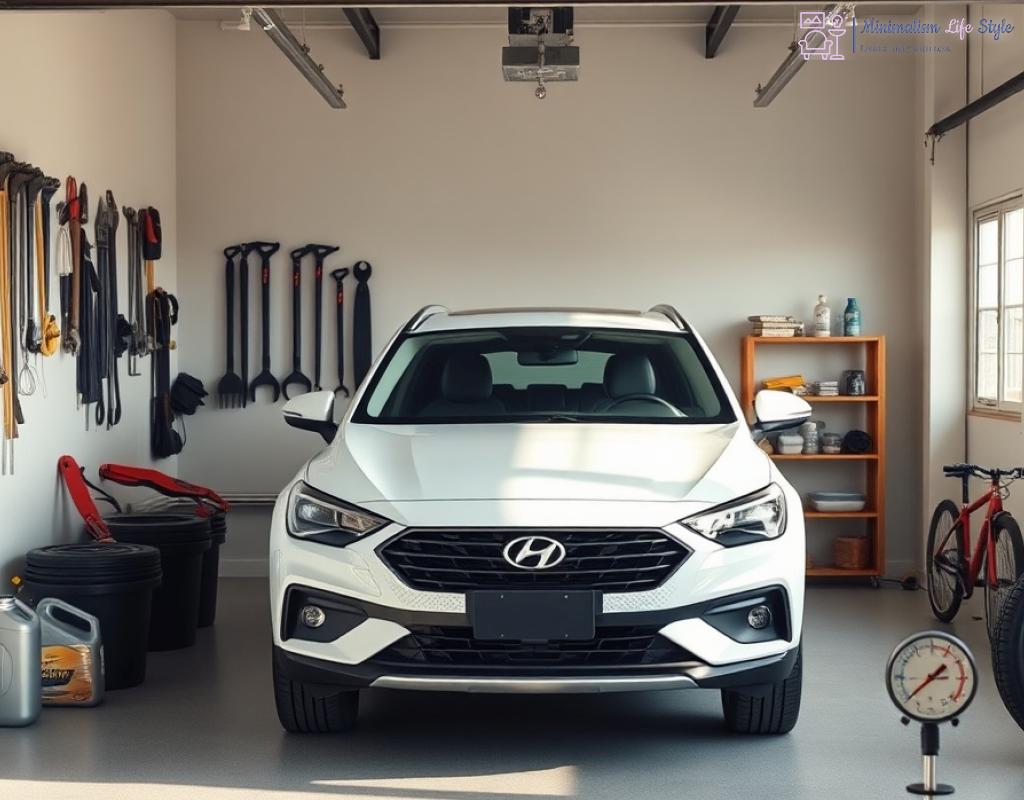The Minimalist’s Guide to Routine Checks

Owning a vehicle can often feel like a daunting task, especially for those who embrace a minimalist lifestyle. However, keeping your family car in top shape doesn’t have to be complicated or time-consuming. By focusing on a few essential routine checks, you can ensure your vehicle remains reliable while minimizing maintenance stress. Here’s how to simplify your approach to car maintenance.
To maintain your vehicle efficiently, it’s crucial to keep an eye on specific components that directly impact performance and safety. The following checklist outlines the vital areas to inspect regularly:
- Oil Levels: Check your oil levels monthly and change it as recommended in your owner’s manual.
- Tires: Inspect tire pressure and tread depth every month to ensure optimal performance.
- Brakes: Listen for unusual noises and feel for any changes in brake performance.
- Lights: Regularly inspect headlights, brake lights, and turn signals for functionality.
- Fluids: Keep an eye on coolant, brake fluid, and windshield washer fluid levels.
- Batteries: Check for corrosion and test battery health at least twice a year.
Incorporating these checks into your routine doesn’t have to be a chore. Here are some efficient maintenance practices that will simplify the process:
- Set Reminders: Utilize your smartphone or calendar to set reminders for routine checks.
- Document Your Findings: Keep a maintenance log to track what has been checked and when.
- DIY Where Possible: Familiarize yourself with basic car maintenance tasks to save time and costs.
By adopting these practices, you’ll not only maintain your vehicle in good condition but also enhance your overall driving experience. Embrace the minimalist ethos and simplify your car maintenance with these essential checks!
Essential Tools for Simple Car Care
When it comes to maintaining your family vehicle, possessing the right tools can make all the difference. For those who prefer a minimalist approach, the goal is to gather only what is necessary while ensuring you have everything you need to keep your car in optimal condition. Here’s a guide to the essential tools that can simplify your car care routine and empower you to tackle basic maintenance tasks with confidence.
Investing in a few key tools can save both time and money while enhancing your ability to perform simple vehicle upkeep. Below is a curated list of essential tools to consider:
- Socket Set: A versatile socket set allows you to tackle a variety of tasks, from changing oil to replacing spark plugs.
- Tire Pressure Gauge: Ensuring your tires are properly inflated is crucial for safety and efficiency.
- Wrench Set: A good set of wrenches can help you with various mechanical adjustments.
- Oil Filter Wrench: This tool simplifies the process of changing your vehicle’s oil filter.
- Car Jack and Stands: Essential for safely lifting your vehicle to perform maintenance underneath.
- Flashlight: A reliable flashlight is key for inspecting hard-to-see areas, especially during night checks.
Having a dedicated space for your car maintenance tools can greatly enhance your efficiency. Here’s how to keep your toolkit organized and easy to access:
- Toolbox or Storage Bin: Invest in a sturdy toolbox or storage bin to house your essential tools and keep them organized.
- Labeling System: Use labels to identify compartments within your toolbox, making it easier to find the tools you need quickly.
- Regular Inventory Check: Periodically assess your tool collection to ensure everything is in working condition and replace any missing items.
Equipping yourself with the right tools is only half the battle; understanding how to use them effectively is equally important. Consider investing time in learning about basic car maintenance procedures through online tutorials or workshops. This knowledge, combined with your minimalist toolkit, will empower you to take charge of your vehicle’s upkeep.
Streamlined Strategies for Fuel Efficiency
For families embracing a minimalist lifestyle, every aspect of vehicle ownership should be efficient, including how we drive. Adopting mindful driving habits can significantly enhance your car’s fuel efficiency. Accelerating smoothly and maintaining a consistent speed can help maximize mileage. Avoiding sudden stops and starts not only conserves fuel but also reduces wear and tear on your vehicle. When driving, consider using cruise control on highways to maintain an optimal speed without unnecessary acceleration.
Keeping your car in peak condition is vital for ensuring it runs efficiently. Regular maintenance checks not only uphold the vehicle’s health but also contribute to better fuel economy. Simple tasks, such as ensuring your tire pressure is within the manufacturer’s recommended range, can make a noticeable difference. Under-inflated tires can increase rolling resistance, causing your engine to work harder and consume more fuel. Additionally, using the recommended motor oil can improve engine efficiency, further enhancing your vehicle’s fuel performance.
A minimalist approach to vehicle ownership extends beyond just maintenance; it also involves minimizing unnecessary weight in your car. Every extra pound can affect fuel efficiency, especially in smaller vehicles. Evaluate the items you keep in your car and remove anything that isn’t essential. Furthermore, consider the benefits of streamlining your vehicle’s aerodynamics by removing roof racks or other accessories when not in use. This not only improves fuel economy but also contributes to a more efficient driving experience.
Understanding Basic DIY Maintenance
For families adopting a minimalist lifestyle, taking care of your vehicle shouldn’t feel overwhelming. In fact, understanding basic DIY maintenance can empower you to manage your car’s upkeep with confidence and ease. By grasping the fundamentals of car care, you can ensure your vehicle remains reliable while minimizing the stress associated with professional services. Let’s delve into the essential DIY maintenance tasks that every family car owner should be familiar with.
Embracing a hands-on approach to vehicle maintenance begins with mastering a few simple repairs. From changing the oil to replacing windshield wipers, these tasks are not only manageable but can also save you significant money over time. For instance, changing the oil is a straightforward process that involves draining the old oil, replacing the filter, and adding new oil. By consulting your vehicle’s manual, you can determine the correct oil type and interval for changes, ensuring optimal engine performance.
Another crucial area of DIY maintenance is understanding how to replace your windshield wipers. This task is often overlooked yet vital for safety during inclement weather. With just a few minutes and minimal tools, you can improve your visibility and drive with confidence.
Even the most reliable vehicles can encounter issues from time to time. Knowing how to troubleshoot basic problems can save you from unnecessary trips to the mechanic. For example, if your car won’t start, it’s essential to check the battery first. Look for signs of corrosion or loose connections, which can often be resolved with a simple cleaning or tightening. Additionally, understanding warning lights on your dashboard can guide you in identifying potential issues before they escalate.
Equipped with a basic understanding of your vehicle’s system, you can also handle minor tasks such as checking the coolant levels or inspecting the air filter. These small, proactive measures contribute significantly to your car’s longevity and performance.
Integrating DIY maintenance into your routine can be seamless, especially when you create a schedule that fits your lifestyle. Consider setting aside time each month to perform basic checks. This could include oil changes, tire pressure assessments, and fluid inspections. By breaking down tasks into manageable segments, you foster a consistent maintenance habit that keeps your vehicle in prime condition.
Furthermore, documenting your maintenance activities can streamline this process. Keeping a simple log of when tasks were performed allows you to track your vehicle’s health over time, making it easier to spot any emerging patterns or issues.
Creating a Maintenance Schedule That Works
Establishing a maintenance schedule that aligns with your family’s lifestyle can significantly enhance your vehicle’s longevity while keeping the process simple and efficient. By organizing your car care tasks into a manageable routine, you can avoid last-minute scrambles and ensure your vehicle remains in optimal condition with minimal effort. Here’s how to create a practical maintenance schedule that fits seamlessly into your life.
Your maintenance schedule should be both strategic and adaptable to your family’s needs. Begin by identifying the key tasks that require regular attention. These tasks can be grouped by frequency, which allows you to create a clear plan. Here’s a helpful list of essential maintenance activities categorized by frequency:
- Monthly Checks: Tire pressure, oil levels, and fluid levels (coolant, brake fluid, windshield washer fluid).
- Quarterly Checks: Battery health, brake performance, and lights functionality.
- Biannual Checks: Tire tread depth, wiper replacement, and air filter inspection.
- Annual Checks: Comprehensive vehicle inspection, fluid flushes, and major service intervals as specified in the owner’s manual.
By laying out your maintenance tasks in this manner, you can easily identify what needs to be done when, making car care less daunting.
Life can be unpredictable, especially for families on the go. Therefore, it’s essential to build flexibility into your maintenance schedule. Consider using a digital calendar or app that allows you to set reminders and alerts for each maintenance task. This ensures you stay on track without feeling overwhelmed. Additionally, establish a fallback plan for tasks that get delayed due to unforeseen circumstances. For instance, if a monthly check is missed, set a specific day within the following week to catch up. Flexibility not only helps maintain your vehicle but also reduces stress associated with missed tasks.
Getting your family involved in car maintenance can turn a mundane chore into a bonding experience. Assign age-appropriate tasks to children, such as checking tire pressure or washing the car, to instill a sense of responsibility and teamwork. Create a family maintenance day, where everyone participates in checking the vehicle, discussing its needs, and planning for future upkeep. This not only simplifies the maintenance process but also teaches valuable lessons about responsibility and care for shared assets.




